 With Florida’s water withdrawals expected to increase by 30% from 2000 to 2030, South Florida vegetable producers are conserving water by converting traditional seepage irrigation systems to drip irrigation, which can have up to 90% efficiency when used effectively. Dye tests can provide important information for implementing a proper drip irrigation management program. This 6-page fact sheet was written by Sanjay Shukla, Nathan Holt, and Gregory Hendricks, and published by the UF Department of Agricultural and Biological Engineering, July 2014.
With Florida’s water withdrawals expected to increase by 30% from 2000 to 2030, South Florida vegetable producers are conserving water by converting traditional seepage irrigation systems to drip irrigation, which can have up to 90% efficiency when used effectively. Dye tests can provide important information for implementing a proper drip irrigation management program. This 6-page fact sheet was written by Sanjay Shukla, Nathan Holt, and Gregory Hendricks, and published by the UF Department of Agricultural and Biological Engineering, July 2014.
http://edis.ifas.ufl.edu/ae506
Category: Environment
Convergent Lady Beetle Hippodamia convergens Guérin-Méneville (Insecta: Coleoptera: Coccinellidae)
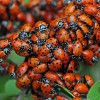 The convergent lady beetle, Hippodamia convergens Guérin-Méneville, is among the most common lady beetle species throughout North America and is an important natural enemy of aphids, scales, thrips, and other soft-bodied insects. It will also feed on pollen and nectar from flowers when prey is scarce. This species can be found in habitats ranging from grasslands, forests, agricultural fields, gardens, and natural parks. It is one of the few natural enemies that are currently wild-collected from mass aggregations for distribution to the pest control industry. This 5-page fact sheet was written by Luis F. Aristizábal and Steven P. Arthurs, and published by the UF Department of Entomology and Nematology, June 2014.
The convergent lady beetle, Hippodamia convergens Guérin-Méneville, is among the most common lady beetle species throughout North America and is an important natural enemy of aphids, scales, thrips, and other soft-bodied insects. It will also feed on pollen and nectar from flowers when prey is scarce. This species can be found in habitats ranging from grasslands, forests, agricultural fields, gardens, and natural parks. It is one of the few natural enemies that are currently wild-collected from mass aggregations for distribution to the pest control industry. This 5-page fact sheet was written by Luis F. Aristizábal and Steven P. Arthurs, and published by the UF Department of Entomology and Nematology, June 2014.
http://edis.ifas.ufl.edu/in1037
Communicating with Extension Clients about Water
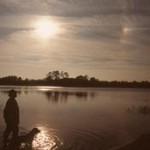 As the U.S. and Florida populations continue to increase and the demand for fresh, clean water rises, water quality and quantity issues will become increasingly important. Extension faculty should understand public opinion surrounding water issues and identify the information that needs to be communicated to the public about water issues, as well as the best mode for this communication. This EDIS publication will provide an overview of how to communicate with Florida residents about water, including information about their preferred communication method and what topics surrounding water Florida residents find of interest. This publication will better equip Extension faculty to discuss water quantity and quality issues with Florida residents. This 4-page fact sheet was written by Caroline G. Roper and Alexa J. Lamm, and published by the UF Department of Agricultural Education and Communication, June 2014.
As the U.S. and Florida populations continue to increase and the demand for fresh, clean water rises, water quality and quantity issues will become increasingly important. Extension faculty should understand public opinion surrounding water issues and identify the information that needs to be communicated to the public about water issues, as well as the best mode for this communication. This EDIS publication will provide an overview of how to communicate with Florida residents about water, including information about their preferred communication method and what topics surrounding water Florida residents find of interest. This publication will better equip Extension faculty to discuss water quantity and quality issues with Florida residents. This 4-page fact sheet was written by Caroline G. Roper and Alexa J. Lamm, and published by the UF Department of Agricultural Education and Communication, June 2014.
http://edis.ifas.ufl.edu/wc165
Water and Nitrogen BMPs for Tomato and Watermelon: Water Quality and Economics
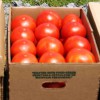 Results of a two-year, four-crop-cycles experiment indicated that the recommended Best Management Practice (BMP) water and fertilizer nitrogen (N) rates for seepage-irrigated tomato in south Florida can reduce water use and N leaching to groundwater without adversely impacting yield. The same is true for watermelon for average rainfall conditions. This 5-page fact sheet was written by Sanjay Shukla, Gregory S. Hendricks, Fritz M. Roka, and Thomas A. Obreza, and published by the UF Department of Agricultural and Biological Engineering, May 2014.
Results of a two-year, four-crop-cycles experiment indicated that the recommended Best Management Practice (BMP) water and fertilizer nitrogen (N) rates for seepage-irrigated tomato in south Florida can reduce water use and N leaching to groundwater without adversely impacting yield. The same is true for watermelon for average rainfall conditions. This 5-page fact sheet was written by Sanjay Shukla, Gregory S. Hendricks, Fritz M. Roka, and Thomas A. Obreza, and published by the UF Department of Agricultural and Biological Engineering, May 2014.
http://edis.ifas.ufl.edu/ae503
Water Withdrawals and Their Use in Florida in 2010
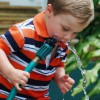 This publication is based on Florida water use information collected by the United States Geological Service. It expands on EDIS document FE797 that examined Florida water withdrawals data for 2005. In addition, in EDIS document FE757 (Florida’s Water Resources), the authors describe Florida’s abundant water resources—the state receives about 54 inches of rainfall per annum, compared to 30 inches nationwide, and it overlies prolific aquifers. Whether water is scarce or abundant, however, depends not only upon available supplies, but also upon patterns of water use. To gather this information, the United States Geological Survey employs several water-use categories to develop estimates of water withdrawals and water use. This 5-page fact sheet was written by Tatiana Borisova and Jenna Rogers, and published by the UF Department of Food and Resource Economics, May 2014.
This publication is based on Florida water use information collected by the United States Geological Service. It expands on EDIS document FE797 that examined Florida water withdrawals data for 2005. In addition, in EDIS document FE757 (Florida’s Water Resources), the authors describe Florida’s abundant water resources—the state receives about 54 inches of rainfall per annum, compared to 30 inches nationwide, and it overlies prolific aquifers. Whether water is scarce or abundant, however, depends not only upon available supplies, but also upon patterns of water use. To gather this information, the United States Geological Survey employs several water-use categories to develop estimates of water withdrawals and water use. This 5-page fact sheet was written by Tatiana Borisova and Jenna Rogers, and published by the UF Department of Food and Resource Economics, May 2014.
http://edis.ifas.ufl.edu/fe943
Socio-Demographic Characteristics and Concerns about Water Quality Issues of Master Gardener Program Volunteers
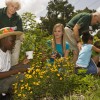 To respond to residents’ informational needs, the Cooperative Extension Service offers a variety of volunteer training and certification programs. Who participates in such programs? What types of audiences are being reached? Do such programs increase knowledge and change behavior of the volunteers? In this article, we attempt to answer these questions by summarizing existing studies and using responses to a regional public survey, and by focusing on the Master Gardener program and surface water quality issues as examples. This 7-page fact sheet was written by Tatiana Borisova, Michael Smolen, Maria Pilar Useche, Jon Calabria, Nickola Sochacka, Damian Adams, Diane Boellstorff, Jason Evans, and Robert Mahler, and published by the UF Department of Food and Resource Economics, May 2014.
To respond to residents’ informational needs, the Cooperative Extension Service offers a variety of volunteer training and certification programs. Who participates in such programs? What types of audiences are being reached? Do such programs increase knowledge and change behavior of the volunteers? In this article, we attempt to answer these questions by summarizing existing studies and using responses to a regional public survey, and by focusing on the Master Gardener program and surface water quality issues as examples. This 7-page fact sheet was written by Tatiana Borisova, Michael Smolen, Maria Pilar Useche, Jon Calabria, Nickola Sochacka, Damian Adams, Diane Boellstorff, Jason Evans, and Robert Mahler, and published by the UF Department of Food and Resource Economics, May 2014.
http://edis.ifas.ufl.edu/fe942
Black salt marsh mosquito Aedes taeniorhynchus (Wiedemann) (Insecta: Diptera: Culicidae)
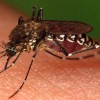 The black salt marsh mosquito is very common in the eastern coastal areas of the Americas, and is responsible for a large part of mosquito insecticide applications in Florida. Although it is not a primary vector of major concern, it can transmit pathogens to humans and other animals. Its characteristic emergence in large numbers after rains and flooding events as well as its aggressive biting contribute to its notoriety as a pest insect. The black salt marsh mosquito is considered a nuisance in Florida. It is sheltered from large-scale mosquito control as part of the Everglades National Park conservation program to preserve their delicate ecosystem. This 7-page fact sheet was written by Natasha Marie Agramonte and C. Roxanne Connelly, and published by the UF Department of Entomology and Nematology, April 2014.
The black salt marsh mosquito is very common in the eastern coastal areas of the Americas, and is responsible for a large part of mosquito insecticide applications in Florida. Although it is not a primary vector of major concern, it can transmit pathogens to humans and other animals. Its characteristic emergence in large numbers after rains and flooding events as well as its aggressive biting contribute to its notoriety as a pest insect. The black salt marsh mosquito is considered a nuisance in Florida. It is sheltered from large-scale mosquito control as part of the Everglades National Park conservation program to preserve their delicate ecosystem. This 7-page fact sheet was written by Natasha Marie Agramonte and C. Roxanne Connelly, and published by the UF Department of Entomology and Nematology, April 2014.
http://edis.ifas.ufl.edu/in1035
Insects: Friend or Foe? Color and Learn!
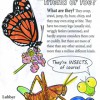 Not just a coloring book, but an interactive learning experience! This educational handout is perfect for classroom use, homeschool, or just a rainy (or snowy, if you are not in Florida) day. This activity will help connect kids and adults with the amazing diversity of animals for which we have articles in the UF/IFAS Featured Creatures database. This coloring book can be printed front to back on a standard 8.5 by 11 inch sheet of paper. Once you have your paper and coloring tools in hand, learn more about these creatures and decide what colors to use by reading more about them and visiting the web links for each insect. This 4-page fact sheet was written by Jennifer L. Gillett-Kaufman, and published by the UF Department of Entomology and Nematology, February 2014.
Not just a coloring book, but an interactive learning experience! This educational handout is perfect for classroom use, homeschool, or just a rainy (or snowy, if you are not in Florida) day. This activity will help connect kids and adults with the amazing diversity of animals for which we have articles in the UF/IFAS Featured Creatures database. This coloring book can be printed front to back on a standard 8.5 by 11 inch sheet of paper. Once you have your paper and coloring tools in hand, learn more about these creatures and decide what colors to use by reading more about them and visiting the web links for each insect. This 4-page fact sheet was written by Jennifer L. Gillett-Kaufman, and published by the UF Department of Entomology and Nematology, February 2014.
http://edis.ifas.ufl.edu/in1030
Rotala: A New Canal Invader in Southern Florida
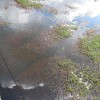 Rotala is a relative newcomer to Florida. Since it was first found in Coral Springs in 1996, it has established large, but mostly isolated, populations throughout the southern regions of Florida. It is especially problematic in Lee and Collier Counties and along the west coast. Extremely dense submersed populations and large thick mats dominate the surface of the water, greatly reducing ecosystem services, because oxygen level and light penetration are hampered. Because the rapid and vigorous growth of rotala inhibits water flow, the ability of infested canals to function properly in flood control systems is greatly hindered. Management of this aquatic weed is a major concern for resource managers. This 4-page fact sheet was written by Lyn A. Gettys and Carl J. Della Torre II, and published by the UF Department of Agronomy, April 2014.
Rotala is a relative newcomer to Florida. Since it was first found in Coral Springs in 1996, it has established large, but mostly isolated, populations throughout the southern regions of Florida. It is especially problematic in Lee and Collier Counties and along the west coast. Extremely dense submersed populations and large thick mats dominate the surface of the water, greatly reducing ecosystem services, because oxygen level and light penetration are hampered. Because the rapid and vigorous growth of rotala inhibits water flow, the ability of infested canals to function properly in flood control systems is greatly hindered. Management of this aquatic weed is a major concern for resource managers. This 4-page fact sheet was written by Lyn A. Gettys and Carl J. Della Torre II, and published by the UF Department of Agronomy, April 2014.
http://edis.ifas.ufl.edu/ag381
Aster leafminer moth Leucospilapteryx venustella (Clemens) (Insecta: Lepidoptera: Gracillariidae)
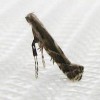 Leucospilapteryx venustella (Clemens) (Lepidoptera: Gracillariidae) is a small, mostly light brown moth that during its larval stages creates mines in the leaves of plants in the family Asteraceae. Feeding damage by the early instars is characterized by serpentine mines that are expanded by later instars to form tentiform or blotch mines. This 4-page fact sheet was written by Rodrigo Diaz, Esteban Tapia, Veronica Manrique, William Overholt, and Donald Davis, and published by the UF Department of Entomology and Nematology, February 2014.
Leucospilapteryx venustella (Clemens) (Lepidoptera: Gracillariidae) is a small, mostly light brown moth that during its larval stages creates mines in the leaves of plants in the family Asteraceae. Feeding damage by the early instars is characterized by serpentine mines that are expanded by later instars to form tentiform or blotch mines. This 4-page fact sheet was written by Rodrigo Diaz, Esteban Tapia, Veronica Manrique, William Overholt, and Donald Davis, and published by the UF Department of Entomology and Nematology, February 2014.
http://edis.ifas.ufl.edu/in1029
Minimizing Honey Bee Exposure to Pesticides
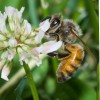 Protecting honey bees and other pollinators from pesticide impacts is important to the sustainability of agriculture. Consequently, pesticide applicators must determine if there is a clear hazard to managed or wild populations of bees. Potential exposure of bees to pesticides can vary greatly depending on the type of pesticide, formulation, application method, label restrictions, and other factors. The goal in using a pesticide is to achieve maximum benefit (success) with minimum negative impact, and these factors should always be considered in pesticide selection. This publication is written (1) to help assure the sustainability of both bees and agriculture by informing beekeepers, pesticide users, and the general public about the often complex relationship between pollinators (specifically bees) and pesticides, (2) to offer guidance for improved communication between beekeepers and pesticide users, (3) to offer pollinator risk-reducing strategies for growers and other applicators when using pesticides, and (4) to provide clarity in laws, labeling, and associated definitions. This 14-page fact sheet was written by J. D. Ellis, J. Klopchin, E. Buss, F. M. Fishel, W. H. Kern, C. Mannion, E. McAvoy, L. S. Osborne, M. Rogers, M. Sanford, H. Smith, P. Stansly, L. Stelinski, and S. Webb, and published by the UF Department of Entomology and Nematology, March 2014.
Protecting honey bees and other pollinators from pesticide impacts is important to the sustainability of agriculture. Consequently, pesticide applicators must determine if there is a clear hazard to managed or wild populations of bees. Potential exposure of bees to pesticides can vary greatly depending on the type of pesticide, formulation, application method, label restrictions, and other factors. The goal in using a pesticide is to achieve maximum benefit (success) with minimum negative impact, and these factors should always be considered in pesticide selection. This publication is written (1) to help assure the sustainability of both bees and agriculture by informing beekeepers, pesticide users, and the general public about the often complex relationship between pollinators (specifically bees) and pesticides, (2) to offer guidance for improved communication between beekeepers and pesticide users, (3) to offer pollinator risk-reducing strategies for growers and other applicators when using pesticides, and (4) to provide clarity in laws, labeling, and associated definitions. This 14-page fact sheet was written by J. D. Ellis, J. Klopchin, E. Buss, F. M. Fishel, W. H. Kern, C. Mannion, E. McAvoy, L. S. Osborne, M. Rogers, M. Sanford, H. Smith, P. Stansly, L. Stelinski, and S. Webb, and published by the UF Department of Entomology and Nematology, March 2014.
http://edis.ifas.ufl.edu/in1027
Valuing the Recreation Uses of Natural Resources: The Travel Cost Method
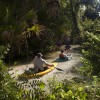 Many available statistics provide evidence that outdoor recreation in Florida generates economic value, but these data do not capture the full recreation value of Florida’s natural resources. The Travel Cost Method (TCM) approach may be applied in cost-benefit analysis and in natural resource damage assessments where recreation values are relevant. This 8-page fact sheet summarizes and synthesizes economic texts on TCM and provides an overview of a case study in which the TCM was used to estimate the nature-based recreation use value of the Apalachicola River Region in Florida. Written by Elizabeth F. Pienaar, and published by the UF Department of Wildlife Ecology and Conservation, January 2014.
Many available statistics provide evidence that outdoor recreation in Florida generates economic value, but these data do not capture the full recreation value of Florida’s natural resources. The Travel Cost Method (TCM) approach may be applied in cost-benefit analysis and in natural resource damage assessments where recreation values are relevant. This 8-page fact sheet summarizes and synthesizes economic texts on TCM and provides an overview of a case study in which the TCM was used to estimate the nature-based recreation use value of the Apalachicola River Region in Florida. Written by Elizabeth F. Pienaar, and published by the UF Department of Wildlife Ecology and Conservation, January 2014.
http://edis.ifas.ufl.edu/uw386
Conservation Easements: Options for Preserving Current Land Uses
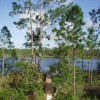 Conservation easements are cost-effective means for government agencies or non-government conservation organizations to protect land. Instead of purchasing land outright, these agreements allow organizations to purchase the development rights of a property. This protects the land and saving money. Landowners who choose this option prevent future residential and commercial development of their land, and reduce the amount of inheritance tax liability. Landowners are encouraged to enter such agreements carefully because they require several rights to be conveyed to the easement grantee and the duration of these agreements is typically perpetual. This 5-page fact sheet describes conservation easements, what is involved in establishing one, tax implications, participating government and non-government organizations, and important considerations for landowners. Written by Chris Demers and Douglas R. Carter, and published by the UF Department of School of Forest Resources and Conservation, March 2014.
Conservation easements are cost-effective means for government agencies or non-government conservation organizations to protect land. Instead of purchasing land outright, these agreements allow organizations to purchase the development rights of a property. This protects the land and saving money. Landowners who choose this option prevent future residential and commercial development of their land, and reduce the amount of inheritance tax liability. Landowners are encouraged to enter such agreements carefully because they require several rights to be conveyed to the easement grantee and the duration of these agreements is typically perpetual. This 5-page fact sheet describes conservation easements, what is involved in establishing one, tax implications, participating government and non-government organizations, and important considerations for landowners. Written by Chris Demers and Douglas R. Carter, and published by the UF Department of School of Forest Resources and Conservation, March 2014.
http://edis.ifas.ufl.edu/fr149
The Potential of Sea-level Rise on Florida’s Coastal Ecosystems
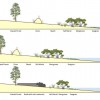 Sea-level rise may have significant effects on Florida’s coastal ecosystems. These ecosystems are the foundation upon which much of Florida’s natural beauty and economy are based. Understanding what changes may happen in the future can help us plan for those changes and, to the extent possible, lessen the impacts of those changes. This 5-page fact sheet was written by Whitney Gray, and published by the UF Department of Sea Grant, October 2013.
Sea-level rise may have significant effects on Florida’s coastal ecosystems. These ecosystems are the foundation upon which much of Florida’s natural beauty and economy are based. Understanding what changes may happen in the future can help us plan for those changes and, to the extent possible, lessen the impacts of those changes. This 5-page fact sheet was written by Whitney Gray, and published by the UF Department of Sea Grant, October 2013.
http://edis.ifas.ufl.edu/sg131
Native Plants That Benefit Native Wildlife in the Florida Panhandle
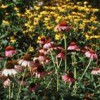 The key to enhancing wildlife (and attracting it to your property) is to provide the resources wildlife need. This means supplying food, water, and cover within the space you own and manage. Because the needs of each wildlife species for food and cover vary from one season to the next, a mix of plant species is required to meet the needs of a species all year round. And because each species has different needs, attracting and maintaining a wide variety of wildlife year round requires a wide diversity of plants. A property owner interested in attracting wildlife should nurture a wide variety of native plants to ensure that there is a large assortment of food and cover options available all the time. This 8-page fact sheet was written by Holly K. Ober and Gary W. Knox, and published by the UF Department of Wildlife Ecology and Conservation, October 2013.
The key to enhancing wildlife (and attracting it to your property) is to provide the resources wildlife need. This means supplying food, water, and cover within the space you own and manage. Because the needs of each wildlife species for food and cover vary from one season to the next, a mix of plant species is required to meet the needs of a species all year round. And because each species has different needs, attracting and maintaining a wide variety of wildlife year round requires a wide diversity of plants. A property owner interested in attracting wildlife should nurture a wide variety of native plants to ensure that there is a large assortment of food and cover options available all the time. This 8-page fact sheet was written by Holly K. Ober and Gary W. Knox, and published by the UF Department of Wildlife Ecology and Conservation, October 2013.
http://edis.ifas.ufl.edu/uw384
Common Sharks of Florida
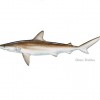 Florida’s shark population is diverse and includes species that range in size from only a few feet to more than 40 feet in total length. Experts caution sea-goers to beware of sharks 6 feet or longer due to the damage they can cause in a single bite. Among the species that grow to this size and have been known to attack humans are bull sharks, tiger sharks and great white sharks. Whites are seasonal visitors to Florida waters, and bulls and tigers are year-round residents, along with these other common species. This 4-page fact sheet was written by Florida Sea Grant, and published by the UF Department of Sea Grant, September 2014.
Florida’s shark population is diverse and includes species that range in size from only a few feet to more than 40 feet in total length. Experts caution sea-goers to beware of sharks 6 feet or longer due to the damage they can cause in a single bite. Among the species that grow to this size and have been known to attack humans are bull sharks, tiger sharks and great white sharks. Whites are seasonal visitors to Florida waters, and bulls and tigers are year-round residents, along with these other common species. This 4-page fact sheet was written by Florida Sea Grant, and published by the UF Department of Sea Grant, September 2014.
http://edis.ifas.ufl.edu/sg062
Corn wireworm Melanotus communis Gyllenhal (Insecta: Coleoptera: Elateridae)
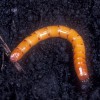 Insects in the family Elateridae are commonly known as click beetles. Their name comes from the clicking sound they make while attempting to right themselves after falling or being placed on their backs. The larvae of click beetles are called wireworms. The corn wireworm is a serious agricultural pest and was added to the EPPO A1 action list of quarantine pests in 2002. This 6-page fact sheet was written by Harsimran K. Gill, Gurminder Chahil, Gaurav Goyal, Jennifer L. Gillett-Kaufman and Ronald Cherry, and published by the UF Department of Entomology and Nematology, January 2014.
Insects in the family Elateridae are commonly known as click beetles. Their name comes from the clicking sound they make while attempting to right themselves after falling or being placed on their backs. The larvae of click beetles are called wireworms. The corn wireworm is a serious agricultural pest and was added to the EPPO A1 action list of quarantine pests in 2002. This 6-page fact sheet was written by Harsimran K. Gill, Gurminder Chahil, Gaurav Goyal, Jennifer L. Gillett-Kaufman and Ronald Cherry, and published by the UF Department of Entomology and Nematology, January 2014.
http://edis.ifas.ufl.edu/in1025
Hydrilla leafcutter moth (unofficial common name) Parapoynx diminutalis Snellen (Insecta: Lepidoptera: Crambidae)
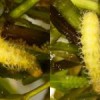 Parapoynx diminutalis Snellen is an adventive Asian moth with an aquatic larval stage. The moth is found associated with a variety of water bodies including river backwaters, lakes, and ponds. The aquatic larvae commonly attack hydrilla and other aquatic plants. The moth was identified in 1971 in India and Pakistan during scouting trips to attempt to determine potential biological control agents for hydrilla. Despite having potential for hydrilla destruction, the moth was declared to be a generalist feeder and unsuitable for release into U.S. water bodies for hydrilla control. But the moth was later found in Florida in 1976 by United States Department of Agriculture technicians who were testing herbicides for hydrilla control. The larvae found on hydrilla were observed to be eating the invasive weed. The pathway, method, or time of the moth’s arrival remains unknown. This 5-page fact sheet was written by Julie Baniszewski, Emma N.I. Weeks, and James P. Cuda, and published by the UF Department of Entomology and Nematology, January 2014.
Parapoynx diminutalis Snellen is an adventive Asian moth with an aquatic larval stage. The moth is found associated with a variety of water bodies including river backwaters, lakes, and ponds. The aquatic larvae commonly attack hydrilla and other aquatic plants. The moth was identified in 1971 in India and Pakistan during scouting trips to attempt to determine potential biological control agents for hydrilla. Despite having potential for hydrilla destruction, the moth was declared to be a generalist feeder and unsuitable for release into U.S. water bodies for hydrilla control. But the moth was later found in Florida in 1976 by United States Department of Agriculture technicians who were testing herbicides for hydrilla control. The larvae found on hydrilla were observed to be eating the invasive weed. The pathway, method, or time of the moth’s arrival remains unknown. This 5-page fact sheet was written by Julie Baniszewski, Emma N.I. Weeks, and James P. Cuda, and published by the UF Department of Entomology and Nematology, January 2014.
http://edis.ifas.ufl.edu/in1024
Erythrina leafminer (suggested common name); Leucoptera erythrinella Busck, 1900 (Insecta: Lepidoptera: Lyonetiidae)
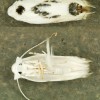 The erythrina leafminer is a member of the genus Leucoptera, which are leaf borers that can cause severe damage to plant crops, such as coffee or apples. Even though these moths are 1/20 to 1/10 the size of an average moth, they can cause serious damage. Leucoptera erythrinella is a pest of the coral bean and other members of the genus Erythrina. The larvae feed inside the leaves, making elaborate and characteristic mines, which from a distance appear to be discolorations of the leaf itself. This 5-page fact sheet was written by Andrei Sourakov, and published by the UF Department of Entomology and Nematology, January 2014.
The erythrina leafminer is a member of the genus Leucoptera, which are leaf borers that can cause severe damage to plant crops, such as coffee or apples. Even though these moths are 1/20 to 1/10 the size of an average moth, they can cause serious damage. Leucoptera erythrinella is a pest of the coral bean and other members of the genus Erythrina. The larvae feed inside the leaves, making elaborate and characteristic mines, which from a distance appear to be discolorations of the leaf itself. This 5-page fact sheet was written by Andrei Sourakov, and published by the UF Department of Entomology and Nematology, January 2014.
http://edis.ifas.ufl.edu/in1023
Stewardship Ecosystem Services Study Series: Assessing Forest Water Yield and Purification Ecosystem Services in the Lower Suwannee River Watershed, Florida
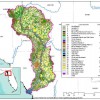 Land-use decisions and ecosystem characteristics affect the amounts of nutrients that end up in water bodies and the ability of the land to provide ecosystem services. Water quality is also highly valued by Florida forest landowners and managers. So, understanding the role of land use and forest cover and types, management practices, and conservation programs in reducing nutrient pollution will allow landowners, forest managers, and policy makers to make informed and better management decisions. In this 6-page fact sheet, we present the results of a study that used easily available models and information to assess the role of forests in providing ecosystem services, including water quality improvement or purification. Specifically, this assessment used available geospatial data and the InVEST Water Purification model to estimate how forest vegetation and soils purify water through the retention, and subsequent export, of nitrogen and phosphorus polluted runoff. Written by Sonia Delphin, Francisco J. Escobedo, Amr Abd-Elrahman, Alison E. Adams, Jackie Martin, Ronald Cademus, and published by the UF Department of School of Forest Resources and Conservation, January 2014.
Land-use decisions and ecosystem characteristics affect the amounts of nutrients that end up in water bodies and the ability of the land to provide ecosystem services. Water quality is also highly valued by Florida forest landowners and managers. So, understanding the role of land use and forest cover and types, management practices, and conservation programs in reducing nutrient pollution will allow landowners, forest managers, and policy makers to make informed and better management decisions. In this 6-page fact sheet, we present the results of a study that used easily available models and information to assess the role of forests in providing ecosystem services, including water quality improvement or purification. Specifically, this assessment used available geospatial data and the InVEST Water Purification model to estimate how forest vegetation and soils purify water through the retention, and subsequent export, of nitrogen and phosphorus polluted runoff. Written by Sonia Delphin, Francisco J. Escobedo, Amr Abd-Elrahman, Alison E. Adams, Jackie Martin, Ronald Cademus, and published by the UF Department of School of Forest Resources and Conservation, January 2014.
http://edis.ifas.ufl.edu/fr385